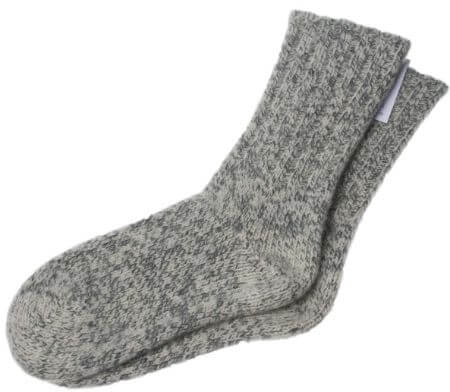As winter approaches, keeping our feet warm and cozy becomes a top priority. When it comes to selecting the right winter socks, two popular options are wool and synthetic materials. Both have their unique qualities and benefits.
In this blog post, we will delve into the characteristics of wool and synthetic winter socks, exploring their insulation properties, moisture-wicking capabilities, comfort, durability, and sustainability aspects.
By understanding these factors, you can make an informed decision and choose the socks that best suit your needs and preferences during the chilly winter months.
Insulation and Warmth
One of the primary considerations when it comes to winter socks is insulation and warmth. Wool socks are renowned for their excellent insulation properties. Wool fibers naturally trap heat, providing exceptional warmth even in cold and damp conditions. They offer excellent thermal regulation, keeping your feet cozy without causing overheating.
On the other hand, synthetic socks, often made from materials like polyester or acrylic, provide good insulation as well. Synthetic fibers are designed to mimic the insulating properties of natural fibers, providing warmth and comfort. They are particularly effective in moisture management, which we will discuss further in the next section.
Moisture-Wicking and Breathability
Moisture management is crucial in winter socks to keep your feet dry and comfortable. Wool socks excel in this aspect due to the natural moisture-wicking properties of wool fibers. Wool can absorb moisture without feeling damp, allowing your feet to stay dry even if you perspire. It also has the ability to regulate moisture, keeping your feet warm even if they get wet.
Synthetic socks are engineered to wick moisture away from the skin quickly. These materials are designed to repel water and promote fast evaporation, ensuring your feet stay dry during activity or in wet conditions. Synthetic socks are particularly suitable for intense physical activities and moisture-prone environments.
Comfort and Cushioning
When it comes to comfort, both wool and synthetic socks have their advantages. Wool socks are known for their softness and natural cushioning. The fibers provide a plush feel and gentle padding, making them comfortable to wear for extended periods. Wool socks also offer excellent breathability, preventing excessive sweating and the associated discomfort.
Synthetic socks, on the other hand, often incorporate cushioning technologies and strategic padding in targeted areas. They provide a snug and supportive fit, reducing fatigue and enhancing overall comfort. Synthetic socks are often designed with ventilation channels and mesh panels to enhance breathability and airflow, ensuring a cool and comfortable feel.
Durability and Longevity
When evaluating the durability of winter socks, wool generally outperforms synthetic materials. Wool fibers are naturally resilient and resistant to wear and tear. Wool socks can withstand frequent use and retain their shape and insulation properties over time. Additionally, wool has inherent antimicrobial properties, making it naturally resistant to odors and reducing the need for frequent washing.
Synthetic socks, while durable, tend to have a shorter lifespan compared to wool. The synthetic fibers can show signs of wear and compression with prolonged use. However, advancements in synthetic materials have led to improved durability and longevity, ensuring that quality synthetic socks can still offer satisfactory performance throughout multiple seasons.
Sustainability Considerations
Sustainability is an important aspect to consider when choosing winter socks. Wool socks, made from natural fibers, are considered a sustainable option. Wool is a renewable resource, as sheep regrow their fleece annually. Additionally, wool is biodegradable, reducing environmental impact at the end of its lifespan.
Synthetic socks, on the other hand, are made from petroleum-based materials and can take a long time to decompose in landfills. However, some brands have made strides in producing eco-friendly synthetic socks, utilizing recycled materials or incorporating sustainable practices in their manufacturing processes.
Conclusion
In conclusion, choosing the right winter socks between wool and synthetic materials depends on your specific needs and preferences. Wool socks offer excellent insulation, moisture-wicking capabilities, and natural comfort. They are highly durable and sustainable, making them a preferred choice for those seeking natural warmth and long-lasting performance.
Synthetic socks, on the other hand, provide good insulation, effective moisture management, and enhanced breathability. They often come with cushioning and support features, catering to different activity levels and specific requirements. While not as sustainable as wool, some brands offer eco-friendly options, incorporating recycled materials and sustainable manufacturing practices.
Consider the intended use, climate, and personal preferences when making your decision. If you prioritize natural fibers, sustainability, and long-lasting durability, wool socks are an excellent choice. If moisture-wicking, breathability, and specific features are your priority, synthetic socks can be a suitable option.
Ultimately, the best winter socks for you will depend on a balance of insulation, moisture management, comfort, durability, and sustainability. Remember to read reviews, try different brands, and prioritize quality to ensure you find the socks that provide warmth, comfort, and satisfaction throughout the winter season. With the right choice, your feet will stay snug and cozy, ready to embrace the winter chill.

For over 12 years, I have been testing and reviewing heating technologies that overcome cold weather conditions. In recent years, I have specialized in the heated apparel. I’ve made it my mission to educate people about heated clothing.
